BREAD SUPPLIED FROM THE ATMOSPHERE
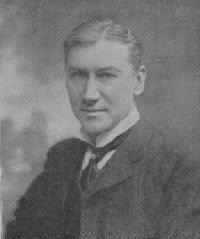 | | Mr. Charles S. Bradley |
Back in 1898, the scientific world was alarmed by the statement of Sir William Crookes to the effect that the bread supply of the world was threatened with exhaustion. Sensational as the remarkable analysis of the situation was, nevertheless, the statement remains broadly true that unless something develops to take the place of the rapidly diminishing supply of nitrogenous fertilizers, the world's wheat supply is sorely threatened by the failing fertility of the soil. Summed up, the eminent scientist's statement was that the world's low average of less than thirteen bushels of wheat per acre means literal starvation for the rapidly increasing nations of wheat eaters, unless aid comes.
NITRATES ESSENTIAL TO WHEAT GROWTH.
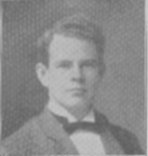 | | Mr. D. R. Lovejoy |
Nitrates supply the fertile qualities of wheat growth, but what of the great and growing wheat areas that before long must starve for soil nutriment? The nitrate doposits of Chile are swiftly being depleted.
The guano beds of the islands of the Pacific even now are cleaned up. The phosphatic beds of the South are strictly limited. Fixed nitrogen in refuse is thrown away with alarming prodigality. Now one hears the prediction that barely 30 years hence it will take 3,200,000,000 bushels of wheat annually to feed the world. This, it is estimated, will neccessitate the use of 12,000,000 tons of nitrate of soda a year, over and above the 1,250,000 now used. But the nitrates in sight now promise a supply for only 50 years. The problem thus is serious in the extreme.
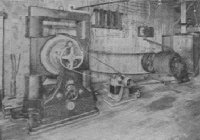 | General view of Arc Machine on left
driven by motor at right, receiving
its current from Niagara Power Plant. |
Science, however, is coming to the rescue. Spurred on by the timely warning of Sir William Crookes, scientists, all over the world are endeavoring to develop artificial means of producing nitrogen in quantities sufficient not only to supply present needs, but to lay up goodly stores for the future. Be it known that there is nitrogen in superabundance in the very atmosphere we breathe. On every square yard of the earth's surface nitrogen is pressing in the form of gas in the air, with a weight of seven tons. The question that is perplexing inventors is that of developing a means of "fixing," or extracting it from the air at a little cost. Chilean nitrate costs $37.50 a ton, while commercial nitric, acid costs $80 a ton. It is with the ceaseless power of Niagara Falls that enough electricity is derived to extract nitrogen from the air so that nitrate of soda ought to be produced at not more than $25 a ton.
Several inventors now have stepped forward in the unique quest for bread from the atmosphere and have erected experimental stations at Niagara Falls. As far back as 1785, Dr. Priestly noted the fact that when a spark of electricity was discharged through the atmosphere the air underwent a chemical change. Any one notices the change in the air after a thunderstorm. The effect of electricity on the air is to enable nitrogen to unite in a chemical combination with oxygen, and thereby become reduced to nitrous acid.
With this knowledge Charles S. Bradley and D. R. Lovejoy have set to work and accomplished much toward the desired goal. After many experiments, they have succeeded at their plant at Niagara Falls in "fixing" nitrogen. The process consists of the production of a large number of electric arcs, or flames, in a confined space, through which a regulated amount of air to be burned is passed from time to time. This air emerges from their apparatus laden with nitric oxides and peroxides, as the result of the combustion, and is ready for collection and treatment.
Many difficulties beset the path of the scientists. An extremely long spark was necessary in order to burn the air. It was found that static electricity, obtained from friction on glass, was not powerful enough to supply the arc desired. The great power of Niagara was turned to their use and fair success resulted.
MACHINERY FOR PRODUCING NITROGEN
OPERATED BY NIAGARA FALLS WATER-POWER
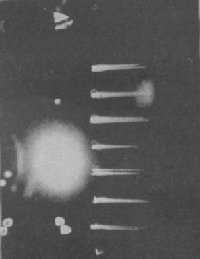 | Eight-inch 10,000-volt
arcs burning the air. |
The device at last invented consists of a big box of metal six feet high and three feet in diameter. Within this box is a revolving cylinder or hollow shaft. There are openings in the box to admit air and to circulate it, and around its walls are fixed electrical contact points for the arcs, arranged in six rows of 23 points each. The negative pole of a 10,000-volt dynamo circuit is connected with the revolving hollow cylinder, which has contact projections or fingers to touch the other contact points.
The affair is set in motion, whirling at a great rate; the arcs are formed and are broken rapidly, causing a constant stream of electrical fire, and the air is "burned up." A motor at the top of the box drives the cylinder at a speed of 300 to 500 revolutions a minute and air is forced through it at the rate of five cubic feet per arc contact, per hour. The air leaves the treatment loaded with 2½ per cent of oxides of nitrogen. At the bottom of the chamber are pockets to catch the decomposed air and thence pipes lead away which carry the air and its gases to an absorption tower, where the process is completed.
 | View showing terminals used for
arcing and burning the air in chamber. |
These gases when brought into contact with caustic potash, form saltpeter; with caustic soda, they form nitrate of soda. The effects expected to be obtained will work to fertilize the wheat lands of the world. Already nitrate of soda is being used to strengthen land properties. It has been found from experiments that land bearing 12 bushels of wheat to the acre, by the nitrate of soda treatment, has produced 36 bushels an acre.
SCIENCE WILL GIVE BREAD TO ALL.
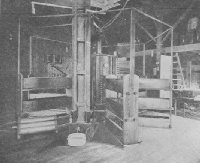 | | Chamber mounted with arcs. |
If this proportionate increase of production holds good in the course of future experimentations, and there seems to be no reason to doubt that such will be the result, the immense wheat-bearing area of the United States, aside from the stimulated growth in other parts of the world, will furnish adequate material for supplying "the staff of life" to generations untold.
Thus science will be found to have responded once more to the needs of humanity in removing the cause of the grave apprehensions which so seriously impressed the mind of Sir William Crookes.
LIQUID AIR—ITS WONDERFUL POWER
LARGEST AND FASTEST TROLLEY CAR
Table of Contents
Return to Main Page
© 1998, 2002 by Lynn Waterman
|





